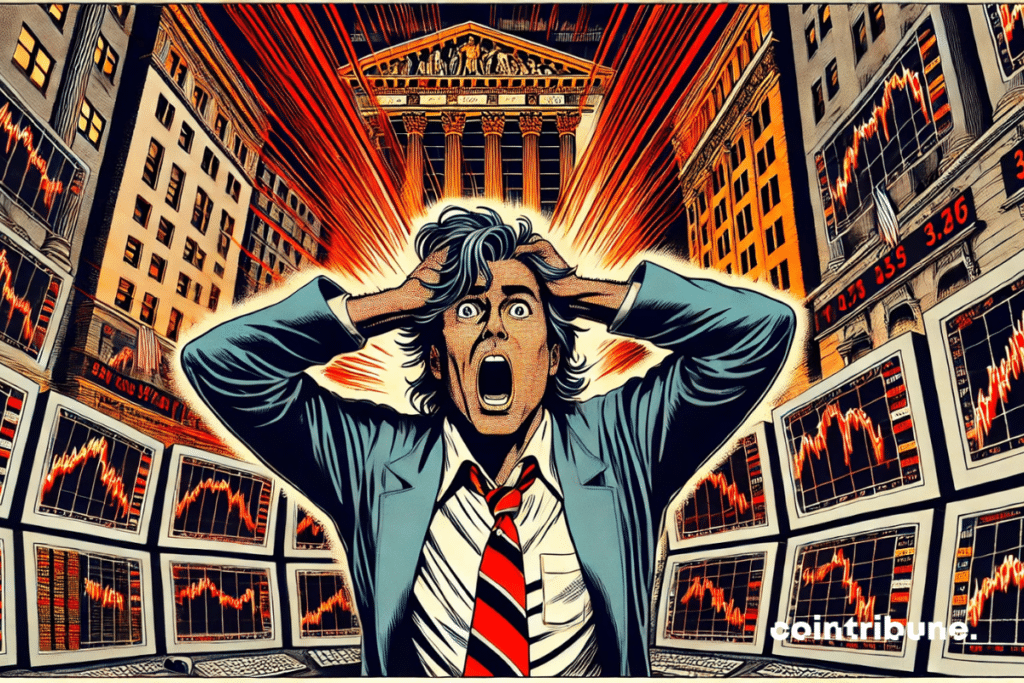Stock Market: The Ghosts Of The 2000 Crash Haunt Wall Street
In the aisles of Wall Street, the atmosphere is no longer festive. For a few weeks now, the American stock market has been showing symptoms of a relapse that we thought forgotten. The specter of a crash — in the style of 2000 or 2008 — resurfaces. And while analysts pull out their old survival manuals, others see it as an opportunity for a big cleanup. But what does history really tell us? And above all, how do we read the signs in this changing economic jungle?

The US stock market in the red: markets repeat their bad sketch
Indeed, the American stock market loves to trip over the carpet of overvaluation. In 2000, the Nasdaq (now aligned with Bitcoin) reached 5,000 points, before crashing down on a 78% drop. A quarter of a century later, are we seeing a repeat? In any case, it looks like it.
The Nasdaq is already down 13% in a month, like a foretaste of an indigestible dish.
Back then, we invested in companies whose only tangible asset was a PowerPoint. Today, it’s artificial intelligences that are sparking euphoria, in the form of Nvidia and its tech cousins. History repeats itself, but with more printed circuits.
As Jim Osman says: ” You haven’t seen anything yet “. He speaks from experience: the Nasdaq, the S&P 500, and the Dow Jones all crashed back then. And this time? Nothing guarantees that the scenario will be less violent.
And you, are you ready for a HD rerun of the 2000 crash?
The United States on the edge of the abyss… or just a brief dizziness?
On the other side of the Atlantic, the United States moves like somnambulists on a thread of debt and illusions. The American economy, on paper, seems robust, but the foundations are cracking. Proof? The famous S&P 500 has slipped over 10% recently, flirting with correction like a shy teenager with disaster.
The profit margins of American companies have reached unprecedented levels: over 9%, far above the historical norm (between 3.8% and 7.2%). It’s no longer an economy, it’s a trampoline. And beware of the landing!
A simple “reversion to the mean” — returning to the average, as professionals say — could plunge profits by 20%, or even more.
Robert Kiyosaki doesn’t mince his words:
This crash will be bigger than that of 1929.
Just that. But don’t panic! According to him, you should “stay stoic, keep your eyes open… and buy when everyone is fleeing “.
Should we tremble or break out the checkbook?
The American stock market: bubble in formation or just a hangover?
As investors try to keep a cool head, one question remains: are we witnessing the bursting of a new bubble or a healthy correction? The indicators are as reassuring as a lace parachute. Some talk about “bull traps”, those false recoveries that precede the real fall.
Remember: in 2001, after the dot-com boom, the market had recovered 21%… before losing 32% again. A repeat in 2008. And today? The valuations are once again under tension. The forward P/E (price-to-earnings ratio) is dangerously approaching 23x, a level that preceded the last two major corrections.
And yet, not all is lost. Artificial intelligence is not just a flash in the pan, as some analysts remind us. The problem is not the technology, but the exuberance of investors, that old demon of Wall Street.
So, is this stock market self-destructing out of enthusiasm?
In summary, the misfortunes of some bring happiness to others: while the American stock market ecosystem, symbolized by Wall Street, is in a dark place right now, it should be noted that it’s Europe that is cashing in.
Maximize your Cointribune experience with our "Read to Earn" program! For every article you read, earn points and access exclusive rewards. Sign up now and start earning benefits.
La révolution blockchain et crypto est en marche ! Et le jour où les impacts se feront ressentir sur l’économie la plus vulnérable de ce Monde, contre toute espérance, je dirai que j’y étais pour quelque chose
The views, thoughts, and opinions expressed in this article belong solely to the author, and should not be taken as investment advice. Do your own research before taking any investment decisions.